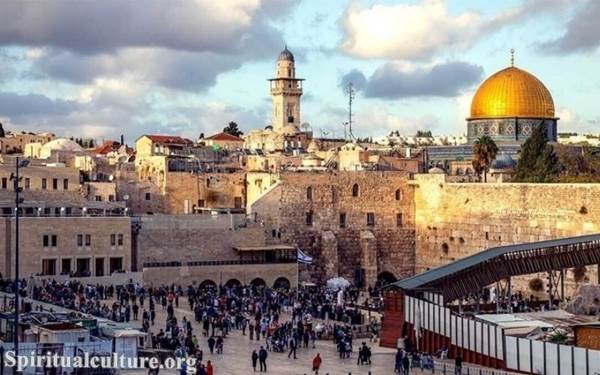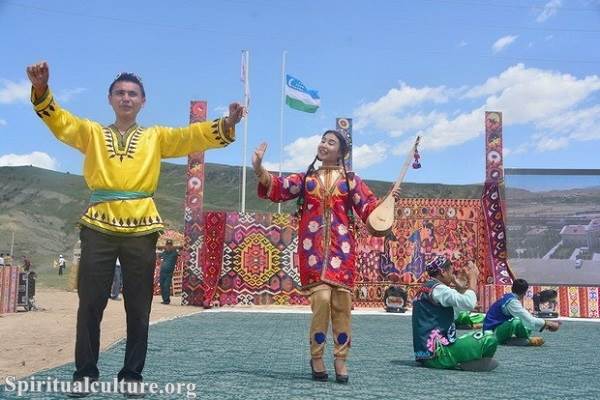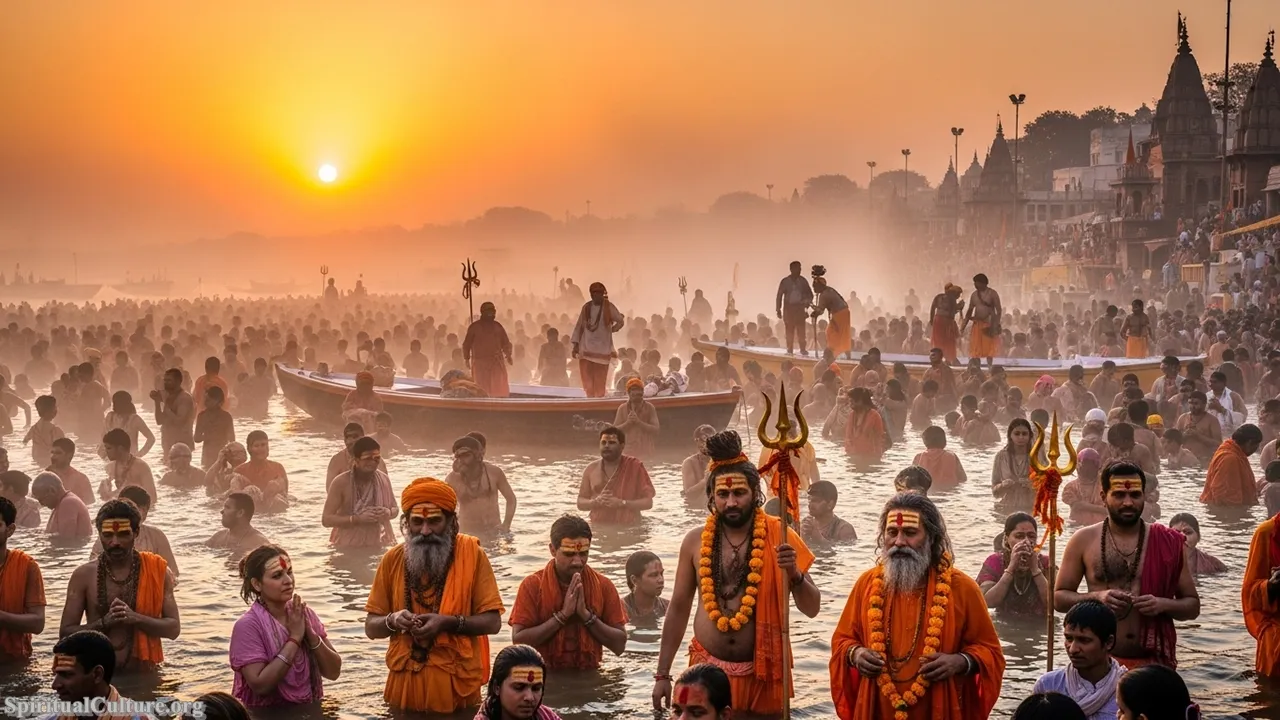Clothing is never merely fabric; it is a profound visual language that narrates history, spiritual beliefs, and the enduring identity of a people. At Spiritual Culture, we view traditional attire—from the elegant drape of a Sari to the bold lines of a Kilt—as a wearable form of cultural heritage. These garments are not relics of the past but living canvases, constantly re-affirmed in celebrations, rituals, and modern life across the globe. As of the Current Time of Writing, the focus on preserving these textile traditions is stronger than ever, reflecting a global commitment to intangible heritage.
This guide delves beneath the surface of mere aesthetics. We explore the deeper, often spiritual, symbolism woven into the threads of the world’s most outstanding traditional dresses. Our ranking is based on a blend of criteria: historical longevity, complexity of craftsmanship, ongoing cultural relevance, and, most importantly, the depth of spiritual or communal meaning each garment conveys.
Join Spiritual Culture as we celebrate the genius of human craft, the devotion to ancestral values, and the stunning beauty of heritage captured in thread and dye. These ten items of clothing are testaments to the power of culture, worn with dignity and representing the soul of their nations.
Table of the Top 10 Traditional Dresses with the Deepest Spiritual and Cultural Significance
| Rank | Traditional Dress | Country/Region | Primary Cultural Significance | Spiritual/Symbolic Element |
|---|---|---|---|---|
| 1 | Kimono | Japan | Symbol of Japanese elegance, patience, and aesthetics (Wabi-Sabi) | Crane motifs for longevity; water/wave patterns for resilience; signifies respect and formality. |
| 2 | Sari (Saree) | India / South Asia | Unstitched length of fabric symbolizing the continuous cycle of life and cosmic flow. | Draping style often indicates marital/social status; specific colors/motifs are auspicious for rituals (Red/Gold for weddings). |
| 3 | Hanbok | Korea | Embodies the “line of the heavens and the earth”—a blend of straight lines and graceful curves. | Vibrant colors reflect the five elements of the Yin and Yang philosophy; pockets were omitted to symbolize non-covetousness. |
| 4 | Kente Cloth Ensemble | Ghana / Ashanti / Ewe | Originally reserved for royalty and spiritual leaders; a powerful symbol of ethnic identity. | Each intricate pattern and color sequence carries a proverb, philosophical concept, or historical narrative (e.g., Sankofa: learning from the past). |
| 5 | Áo Dài | Vietnam | National costume representing grace, modesty, and the fusion of modernity with heritage. | Two panels symbolize a woman’s parents; the five buttons on the torso represent the five cardinal human virtues. |
| 6 | Kilt (Tartan) | Scotland / Gaelic | A powerful marker of clan identity, loyalty, and defiance against cultural oppression. | Specific tartan patterns identify the wearer’s clan and region, symbolizing familial and territorial allegiance; the garment is a symbol of resilience. |
| 7 | Huipil | Guatemala / Mexico (Indigenous) | A traditional woven tunic, serving as a canvas for regional cosmology and identity. | Embroidery motifs are often sacred, depicting nature, deities, or the cosmos; the central neck opening may represent the sun or the universe’s center. |
| 8 | Qipao / Cheongsam | China | A garment that evolved into a modern symbol of refined Chinese femininity and metropolitan elegance. | High collar symbolizes modesty; intricate embroidery often features spiritual motifs like the dragon (power) and phoenix (grace). |
| 9 | Quechua Clothing (Pollera, Lliclla) | Andes (Peru, Bolivia) | A layered ensemble reflecting a deep connection to the Andean environment (Pachamama—Mother Earth). | Vibrant colors and woven patterns (e.g., in the lliclla shawl) often depict local cosmology, protecting the wearer from the high-altitude cold and spirits. |
| 10 | Kebaya and Batik | Indonesia / Malaysia | The traditional blouse (Kebaya) paired with the intricately patterned wrapped cloth (Batik). | Batik motifs are imbued with spiritual meaning; Parang (sword pattern) was historically reserved for royalty, symbolizing wisdom and divine power. |
Top 10. Kebaya and Batik (Indonesia / Malaysia)
The Kebaya, a delicate, embroidered, form-fitting blouse, paired with the vibrant wrapped Batik cloth, stands as a testament to the sophisticated textile traditions of Southeast Asia. Originating as attire for Javanese nobility, the ensemble has become the national dress for Indonesian women and a significant cultural icon across the Malay archipelago. Its elegance lies in the striking contrast between the tailored upper garment and the flowing, richly patterned lower cloth, worn for formal events, national celebrations, and cultural rituals as of the Current Time of Writing.
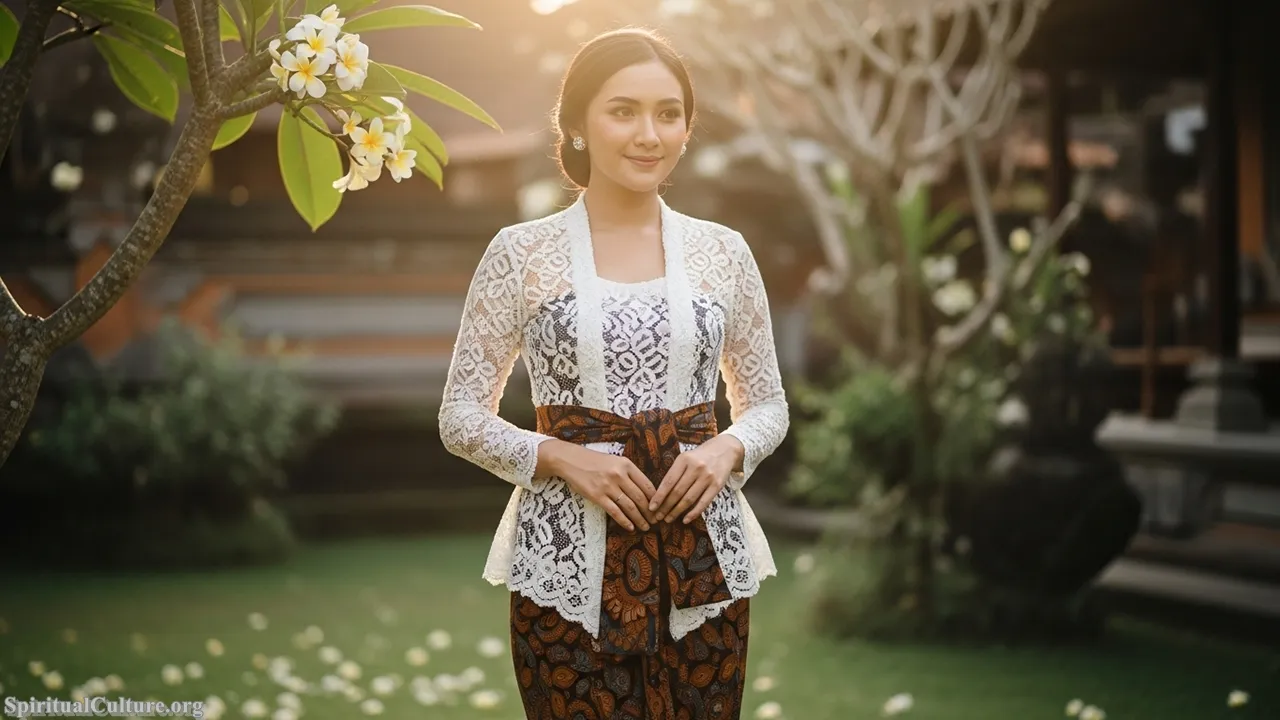
The true spiritual heart of this ensemble lies in the Batik. This art form is a UNESCO-recognized Intangible Cultural Heritage, where wax-resist dyeing creates patterns imbued with profound meaning. Specific motifs, like the Parang Rusak (broken sword), were once forbidden to all but royalty, symbolizing control, wisdom, and the perpetual cycle of life and struggle. The multi-day, sometimes multi-month, process of creation is a meditative act of devotion, transferring ancestral stories and sacred geometries onto the fabric.
The Kebaya and Batik teach a powerful lesson in concealed strength: the soft, feminine silhouette belies the profound, spiritual complexity of the hand-crafted textile it wraps. It underscores the cultural principle that true power and heritage are found not in loud assertion, but in patient, deliberate creation. Preserving Batik is preserving a meditative dialogue with history itself.
Cultural/Spiritual Highlights
- UNESCO Status: Batik is recognized as an Intangible Cultural Heritage of Humanity (Indonesia).
- Sacred Motifs: Patterns like the Semen (sprout) symbolize life and fertility.
- Process as Prayer: The traditional wax-resist dyeing process is a reflective, generational craft.
- Elegance and Modesty: The high-collared Kebaya emphasizes feminine grace and composure.
Top 9. Quechua Clothing (Pollera, Lliclla) (Andes – Peru, Bolivia)
The traditional clothing of the Quechua women—characterized by layers of brightly colored Pollera skirts, the woven Lliclla shawl, and distinctive hats—is a vibrant display of resilience in the high Andes. Born from a blend of pre-colonial indigenous aesthetics and Spanish colonial peasant dress, this attire is a practical, yet stunningly beautiful, adaptation to a challenging environment. It immediately communicates the wearer’s community, marital status, and a deep-seated pride in their connection to the land, an identity maintained fiercely as of the Current Time of Writing.

The spiritual impact is entirely rooted in the Quechua people’s relationship with Pachamama (Mother Earth). The intense, naturally-dyed colors reflect the vibrancy of the high-altitude landscape and its sacred elements, such as the Apus (mountain deities). The layers of the Pollera provide not just warmth but are seen as protective sheaths, while the Lliclla (shawl) is used to carry both children and the harvest, embodying the dual sacred roles of nurturing life and sustaining the community through the earth’s bounty.
This ensemble is a lesson in holistic living, demonstrating that true beauty and spiritual alignment arise from practicality and harmony with nature. It is a daily, wearable prayer for protection and abundance. The preservation challenge lies in sustaining the demanding traditional weaving and dyeing techniques against the tide of globalization, ensuring this bright legacy continues to honor the mountain spirits.
Cultural/Spiritual Highlights
- Pachamama Connection: Colors and weaves are inspired by and honor the Andean natural world.
- Symbol of Resilience: Layers provide protection from the elements, reflecting the tenacity of the people.
- Lliclla’s Dual Role: The shawl serves as a tool for carrying life (child) and livelihood (harvest).
- Community Identity: Hats and specific weaving motifs distinctly identify the wearer’s village and social standing.
Top 8. Qipao / Cheongsam (China)
The Qipao (or Cheongsam in Cantonese) is a sleek, form-fitting dress that symbolizes the fusion of Chinese tradition with metropolitan sophistication, flourishing during the Shanghai era of the 1920s and 30s. Evolving dramatically from the loose robes of the Manchu women (the Banner People), its contemporary high-necked, side-slit design represents a globalized image of refined Chinese femininity. It remains the essential choice for weddings, diplomatic functions, and major cultural festivals as of the Current Time of Writing.

The dress carries a quiet spiritual resonance through its devotion to detail. The high mandarin collar dictates modesty, while the fabric’s often intricate embroidery serves as a vessel for powerful Chinese spiritual motifs. The presence of the Dragon and Phoenix pattern, representing male and female balance (Yin and Yang), is common in ceremonial Qipaos, signifying cosmic harmony, power, and grace. The silk fabric itself, a hallmark of China’s heritage, speaks to an ancient, refined spiritual culture.
The Qipao teaches the moral lesson that deep cultural value can thrive through adaptation. While its style modernized, its core essence—the emphasis on composure, poise, and subtle strength—remained. It is a powerful cultural ambassador, proving that tradition can be both timeless and utterly contemporary, offering a dignified vision of a modern woman rooted in ancient culture.
Cultural/Spiritual Highlights
- Yin/Yang Symbolism: Often features the Dragon and Phoenix motifs to represent balance and power.
- Modesty and Grace: The high collar, or mandarin collar, is a symbol of refinement and propriety.
- Silk Heritage: Crafted primarily from silk, referencing China’s foundational textile tradition.
- Evolution of Identity: Symbolized the independence and elegance of modern Chinese women in the 20th century.
Top 7. Huipil (Guatemala / Mexico – Indigenous)
The Huipil is a loose, sleeveless tunic worn by indigenous women across Central America, particularly in the Mayan regions of Guatemala and Mexico. For many centuries, it has served as the core traditional garment, made from hand-woven fabric, often on a backstrap loom. Each Huipil is a distinct regional marker, with colors, patterns, and stitching techniques unique to the specific village and weaver, acting as a profound document of cultural identity that is actively preserved as of the Current Time of Writing.

Spiritually, the Huipil is a sacred, wearable cosmology. Many weavers view the creation process as a form of meditation and prayer, with the garment itself representing the universe. The central neck opening is often seen as the point where the weaver, the wearer, and the cosmos meet—the center of the universe. The embroidered and woven motifs are not merely decorative; they depict sacred animals, deities, natural elements, and geometric patterns that tell stories of creation, the cyclical nature of time, and the wearer’s relationship with the gods.
The preservation value of the Huipil is immense, as it encapsulates centuries of textile knowledge and spiritual philosophy. It reminds us that identity and faith can be literally woven into the fabric of life, serving as a moral lesson that every thread has a story. To wear a traditional Huipil is to wear one’s spiritual, familial, and community lineage.
Cultural/Spiritual Highlights
- Wearable Cosmology: The garment’s form often represents the structure of the universe or the Earth.
- Sacred Geometry: Patterns and colors encode ancient Mayan narratives and beliefs.
- Weaving as Meditation: The creation on the backstrap loom is viewed as a deeply spiritual, meditative practice.
- Community Code: The specific colors and patterns identify the wearer’s village/tribe instantly.
Top 6. Kilt (Tartan) (Scotland / Gaelic)
The Kilt, famously associated with Scottish Highland men, is a pleated garment of wool in a distinctive tartan pattern. Its origins trace back to the Great Kilt (Fèileadh Mòr)—a multi-yard, unsewn blanket that served as both a practical garment and a sleeping cloak for Highlanders. Today, the modern tailored kilt is an internationally recognized symbol of Scottish and Gaelic heritage, worn with immense pride at formal occasions, from weddings and national games to military ceremonies, holding its powerful position as of the Current Time of Writing.

The spiritual and cultural significance rests entirely on the tartan pattern. The interweaving lines and colors of each tartan are not random; they are a centuries-old code that identifies the wearer’s specific clan, region, or family line, symbolizing unshakeable loyalty and ancestral connection. Furthermore, the kilt’s very existence is a spiritual testament to the Scottish people’s resilience: it was famously banned by the British government for 36 years after the Battle of Culloden (1746). To wear the kilt today is an act of celebrating defiance, pride, and the enduring spirit of Gaelic culture.
The kilt offers a potent reflection on the meaning of heritage: it is a legacy worth fighting for. The material represents not just aesthetics, but a binding covenant with one’s ancestry, a physical reminder of one’s place in the long, often difficult, history of a people. It teaches us the importance of visible markers of identity in the face of cultural erasure.
Cultural/Spiritual Highlights
- Clan Identity: Tartan patterns are a codified visual language identifying the wearer’s family line and region.
- Symbol of Defiance: The kilt became a symbol of national spirit after being outlawed (1746-1782).
- Material Origin: Woven wool reflects the practical, rugged, and unpretentious character of the Highlands.
- Ancestral Pride: Worn at all major life ceremonies, linking the wearer to the lineage.
Top 5. Áo Dài (Vietnam)
The Áo Dài, Vietnam’s national costume, is a long, split tunic worn over trousers, renowned globally for its graceful, form-fitting silhouette. Evolving from earlier courtly and peasant styles, its modern form was popularized in the 20th century, becoming an iconic symbol of Vietnamese womanhood, grace, and national unity. Despite shifts in fashion, the Áo Dài remains a mandatory uniform for high school girls and is worn for major holidays like Tết, reinforcing its cultural role as of the Current Time of Writing.
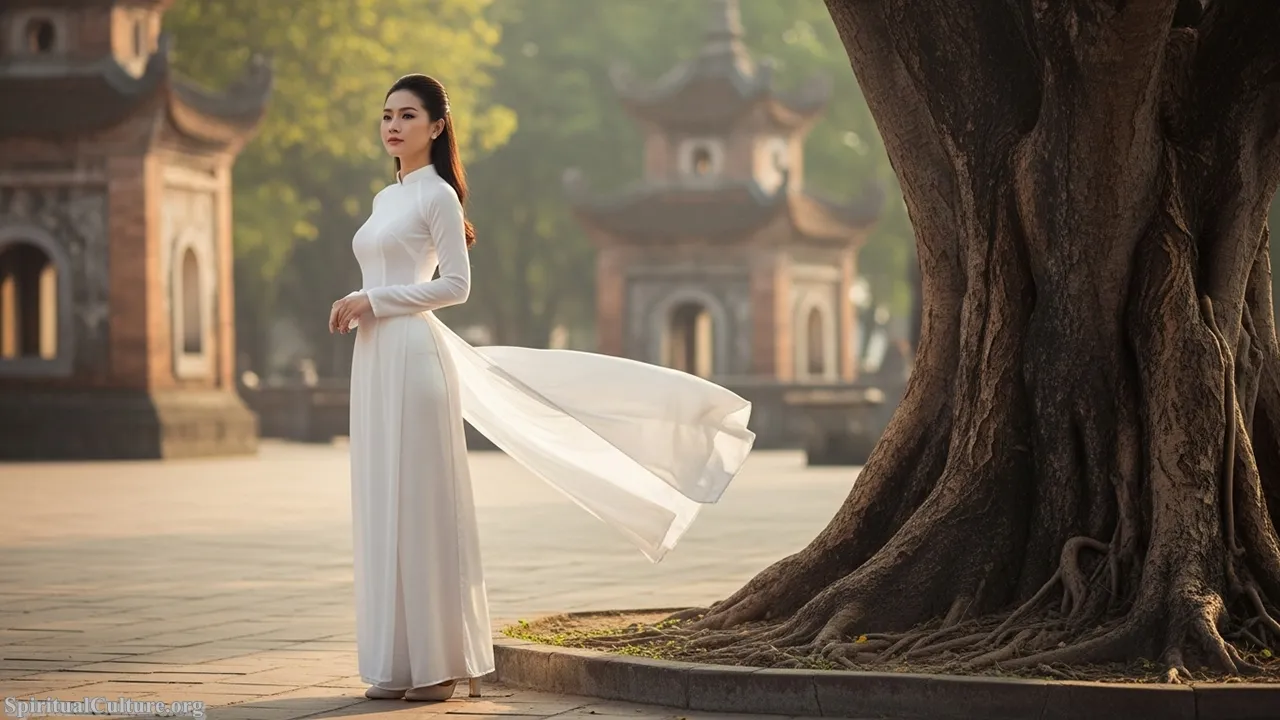
The spiritual symbolism woven into the Áo Dài is deeply reflective of traditional Vietnamese and East Asian morality. The two long panels of the tunic are said to represent the purity and integrity of the individual, while the five buttons along the torso symbolize the five cardinal virtues of humanity (Humanity, Propriety, Honesty, Knowledge, and Trust). The graceful, flowing movement it creates embodies the gentle, soft-spoken nature of Vietnamese culture, prioritizing inner refinement over overt display, promoting modesty and demureness.
The Áo Dài embodies the virtue of poise and quiet strength. Its preservation efforts, including its recognition as a National Intangible Heritage in regions like Huế, reflect a national commitment to protecting its aesthetic and moral value. It teaches a valuable lesson: true beauty is rooted in virtue and is revealed through elegant simplicity and respectful conduct.
Cultural/Spiritual Highlights
- Five Virtues: The five buttons traditionally represent the five cardinal human virtues.
- Familial Respect: The two main panels are sometimes said to represent the woman’s two parents.
- Grace and Modesty: The high collar and long length emphasize poise and refinement.
- National Heritage: Officially recognized as a National Intangible Heritage in key regions of Vietnam.
Top 4. Kente Cloth Ensemble (Ghana – Ashanti / Ewe)
Kente cloth, hand-woven in the looms of Ghana, is one of the world’s most visually stunning and textually rich fabrics. Originally a cloth reserved exclusively for Ashanti kings and high-ranking spiritual leaders, it is now the premier ceremonial dress in Ghana and is widely embraced by the African diaspora. Its value is determined not only by the skill of its creation but by the profound wisdom encoded within its brilliant, complex geometric patterns, maintained as a vibrant cultural force as of the Current Time of Writing.
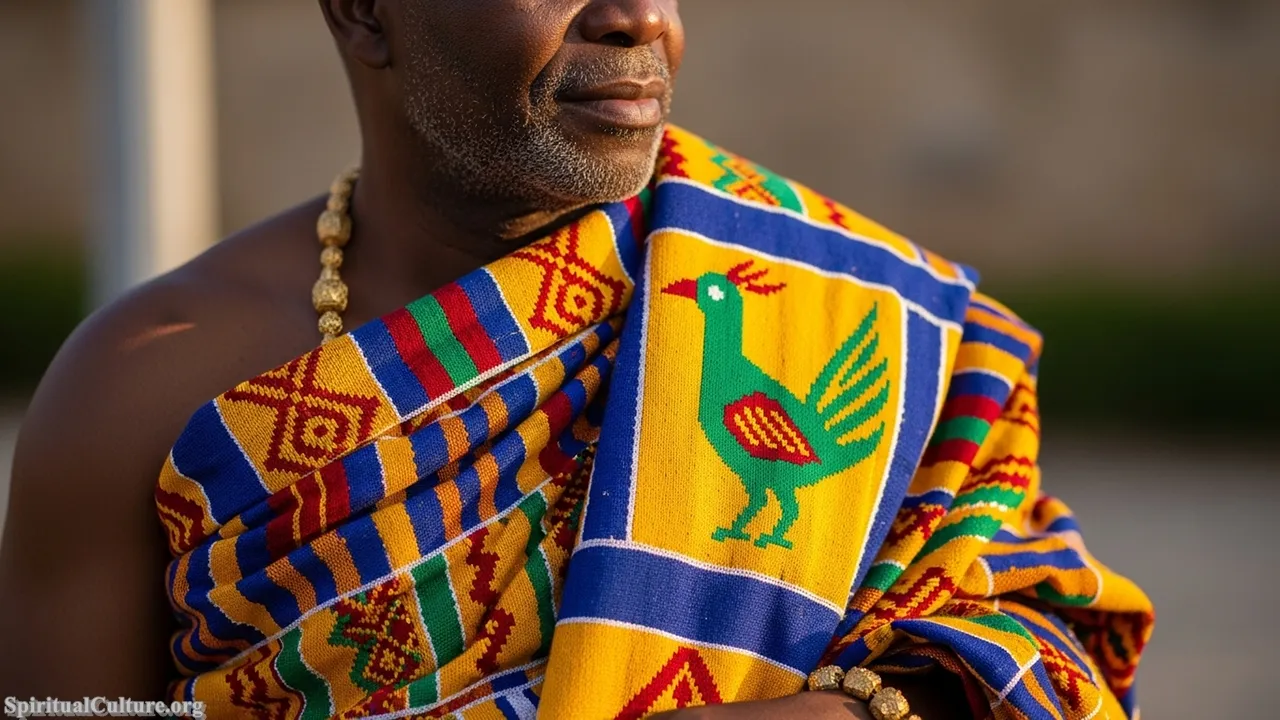
The Kente ensemble is a library of spiritual and historical knowledge. Each pattern, color, and weave structure has a name, a proverb, or a concept—a philosophical worldview woven into the threads. For example, the pattern Sankofa translates to “go back and get it,” symbolizing the wisdom of learning from the past. Red symbolizes blood, sacrifice, and political passion, while gold represents status, wealth, and spiritual purity. To wear a specific Kente pattern is to publicly declare one’s lineage, status, and commitment to specific moral or spiritual principles.
The Kente cloth compels us to value wisdom and narrative over transient fashion. Its reflection is the enduring human need to communicate deep truths visually. The garment’s preservation serves as a moral instruction: one’s identity is not to be bought, but to be woven—a continuous, conscious act of learning and inheriting ancestral knowledge.
Cultural/Spiritual Highlights
- Philosophical Code: Every pattern has a name that represents a proverb or moral principle (e.g., Sankofa).
- Royal Origin: Historically reserved for Ashanti kings and high spiritual ceremonies.
- Color Symbolism: Gold for royalty/spiritual purity; Green for fertility/harvest; Red for passion/sacrifice.
- Wearable History: A physical manifestation of Ghanaian history and cultural philosophy.
Top 3. Hanbok (Korea)
The Hanbok, the traditional dress of Korea, is famed for its vibrant colors, elegant, clean lines, and simple, graceful shape. The women’s Hanbok consists of the Jeogori (short jacket) and the voluminous Chima (skirt), while the men’s includes the Jeogori and Baji (trousers). Though its style evolved through various dynasties, its characteristic wide sleeves and high waist, creating a look of soaring grace, have persisted, making it essential for traditional holidays, weddings, and formal ancestral rites as of the Current Time of Writing.
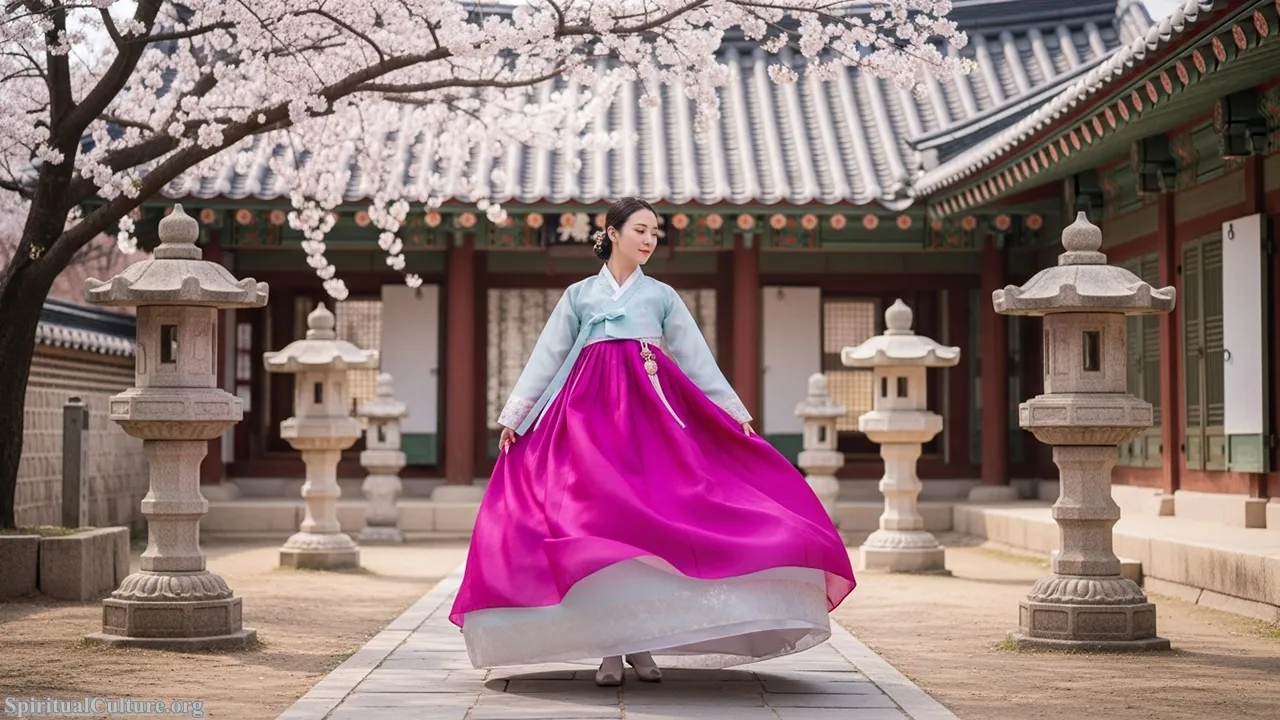
The Hanbok embodies the Taoist philosophy of Yin and Yang and the harmony between straight lines and flowing curves—often called the “line of the heavens and the earth.” The deliberate omission of pockets in traditional Hanbok symbolizes a rejection of covetousness and a focus on inner spiritual wealth. The colors historically represented the Five Elements (red, blue, yellow, black, white), corresponding to directions and natural forces, visually reinforcing the wearer’s harmony with the cosmos. Furthermore, the fullness of the skirt often hid the movement of the legs, promoting a spiritual ideal of composure and deliberate movement.
The Hanbok is a reflection on the beauty of ethical form. It teaches that clothing can gently dictate conduct, encouraging a demeanor of patience, respect, and grace. Its enduring appeal demonstrates that modesty and profound visual design are not mutually exclusive, but are, in fact, complementary spiritual ideals.
Cultural/Spiritual Highlights
- Cosmic Harmony: Colors represent the Five Elements (O-haeng) and Yin-Yang balance.
- Modesty and Composure: The design promotes a slow, graceful, and refined demeanor.
- Symbolic Purity: Traditional Hanbok often lacked pockets to symbolize non-materialistic values.
- Simplicity of Line: The blend of straight and curved lines reflects the harmony of heaven and earth.
Top 2. Sari (Saree) (India / South Asia)
The Sari, an unstitched length of cloth, is arguably the world’s most enduring and versatile garment, worn for millennia by women across the Indian subcontinent. Ranging from five to nine yards, this single piece of fabric is draped over the body in myriad regional styles, paired with a fitted blouse (Choli) and a petticoat. Its incredible diversity in material (silk, cotton), weave (Kanjeevaram, Banarasi), and color palette makes it a profound testament to the unparalleled depth of South Asian textile craftsmanship, holding an uninterrupted cultural history as of the Current Time of Writing.
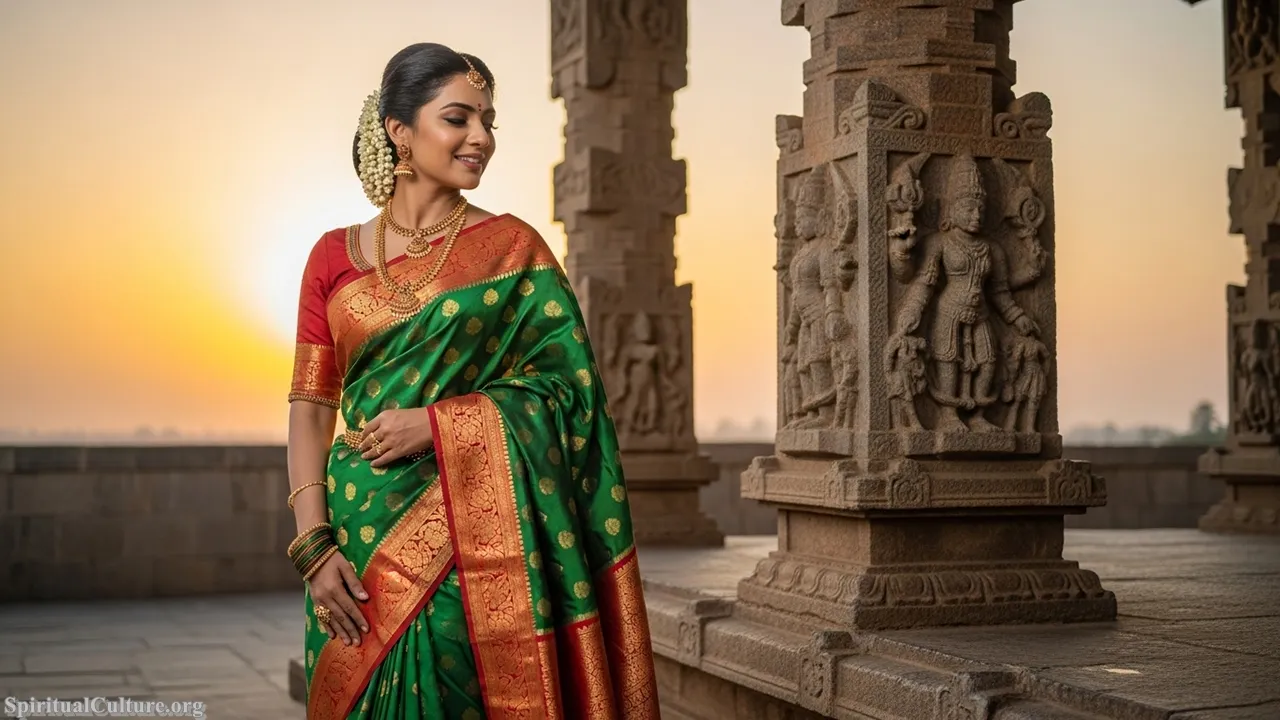
The Sari’s spiritual significance is embedded in its very form: the unstitched nature of the cloth symbolizes the continuous, uninterrupted cycle of life and the cosmic flow of the universe—it is cloth in its purest, most essential state, devoid of the severance of stitches. The draping style often conveys social status, marital status, and regional religious adherence. The colors are deeply auspicious, with Red and Gold being paramount for weddings, symbolizing fertility, prosperity, and the presence of the Goddess Lakshmi. It is the ritual attire for nearly every major life event and temple ceremony.
The Sari is the ultimate reflection on the concept of boundlessness and versatility, teaching that the deepest spiritual truths are found in simplicity. The preservation of its 100+ draping styles and thousands of weaving traditions is a preservation of a living religious and cultural history, a silent testament to the strength and grace of the feminine spirit.
Cultural/Spiritual Highlights
- Cosmic Symbolism: The unstitched cloth represents the unbroken, continuous cycle of life.
- Auspicious Colors: Red and Gold are essential for Hindu weddings, signifying prosperity and the divine.
- Versatility: Its more than 100 draping styles reflect India’s vast religious and cultural diversity.
- Worn by Deities: The garment is a direct descendant of attire depicted on ancient temple sculptures.
Top 1. Kimono (Japan)
The Kimono, meaning “a thing to wear” (Ki = wear, Mono = thing), is the quintessential symbol of Japan’s serene elegance and cultural depth. This T-shaped, straight-lined robe is secured by a wide sash (Obi), and its wearing is an art form rooted in centuries of etiquette and aesthetic tradition. Worn for high ceremonies, festivals, and rites of passage, the Kimono is not simply clothing; it is a meticulously crafted, seasonal work of art that embodies the philosophy of Wabi-Sabi—finding beauty in transient simplicity, and its preservation is a high national priority as of the Current Time of Writing.

The Kimono’s spiritual impact is multifaceted, encoded in every element. Motifs like the crane (longevity) or cherry blossoms (the transient beauty of life, Mono no aware) imbue the garment with wishes and spiritual meditations. The formality of the Kimono—its precise folds, the deliberate tying of the Obi, and the required slow, measured steps of the wearer—enforces a spiritual discipline, prioritizing politeness, composure, and respect for tradition. It serves as a physical reminder of the importance of harmony between self, nature, and society.
The Kimono holds the top rank because its enduring beauty is inseparable from its code of conduct. It teaches that true spiritual life is an act of deep ritual and careful attention to detail. To wear it is to enter a state of reverence for one’s culture and the cyclical rhythm of nature. Its preservation is a commitment to the profound connection between aesthetic discipline and spiritual wisdom.
Cultural/Spiritual Highlights
- Wabi-Sabi Principle: Embodies the Japanese aesthetic ideal of finding beauty in simple, imperfect transient forms.
- Longevity Symbolism: Cranes and pine trees woven into the fabric represent long life and perseverance.
- Ritual Conduct: The garment’s form dictates a slow, deliberate, and respectful movement.
- Seasonal Alignment: Fabric choice and motifs are strictly chosen to reflect the current season, aligning the wearer with nature.
A Timeless Wardrobe of the Soul
The traditional dresses of the world are far more than museum pieces; they are the living, breathing archives of our shared human story. From the unstitched purity of the Indian Sari to the culturally encoded geometry of the Ghanaian Kente and the aesthetic discipline of the Japanese Kimono, these garments demonstrate that the drive for spiritual meaning is literally woven into the fabric of our lives. They speak of values—of resilience, respect, modesty, and the sacred connection to nature and ancestry—that transcend geographic boundaries.
At Spiritual Culture, we urge you to look closer at the world’s attire. Each stitch is a prayer, and every fold holds a lesson. By honoring these textile traditions as active parts of our cultural heritage, we ensure that the profound wisdom of our ancestors continues to adorn and guide us.

